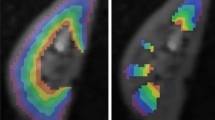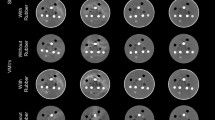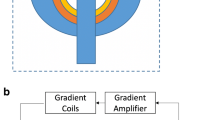Abstract
Longer examination time, need for anesthesia in smaller children and the inability of most children to hold their breath are major limitations of MRI in pediatric body imaging. Fortunately, with technical advances, many new and upcoming MRI sequences are overcoming these limitations. Advances in data acquisition and k-space sampling methods have enabled sequences with improved temporal and spatial resolution, and minimal artifacts. Sequences to minimize movement artifacts mainly utilize radial k-space filling, and examples include the stack-of-stars method for T1-weighted imaging and the periodically rotated overlapping parallel lines with enhanced reconstruction (PROPELLER)/BLADE method for T2-weighted imaging. Similarly, the sequences with improved temporal resolution and the ability to obtain multiple phases in a single breath-hold in dynamic imaging mainly use some form of partial k-space filling method. New sequences use a variable combination of data sampling methods like compressed sensing, golden-angle radial k-space filling, parallel imaging and partial k-space filling to achieve free-breathing, faster sequences that could be useful for pediatric abdominal and thoracic imaging. Simultaneous multi-slice method has improved diffusion-weighted imaging (DWI) with reduction in scan time and artifacts. In this review, we provide an overview of data sampling methods like parallel imaging, compressed sensing, radial k-space sampling, partial k-space sampling and simultaneous multi-slice. This is followed by newer available and upcoming sequences for T1-, T2- and DWI based on these other advances. We also discuss the Dixon method and newer approaches to reducing metal artifacts.














Similar content being viewed by others
References
Smith-Bindman R, Kwan ML, Marlow EC et al (2019) Trends in use of medical imaging in U.S. health care systems and in Ontario, Canada, 2000–2016. JAMA 322:843–856
Yoon JH, Nickel MD, Peeters JM, Lee JM (2019) Rapid imaging: recent advances in abdominal MRI for reducing acquisition time and its clinical applications. Korean J Radiol 20:1597–1615
Bardo DME, Rubert N (2022) Radial sequences and compressed sensing in pediatric body magnetic resonance imaging. Pediatr Radiol 52:382–390
Larkman DJ, Nunes RG (2007) Parallel magnetic resonance imaging. Phys Med Biol 52:R15–R55
Hamilton J, Franson D, Seiberlich N (2017) Recent advances in parallel imaging for MRI. Prog Nucl Magn Reson Spectrosc 101:71–95
Kozak BM, Jaimes C, Kirsch J, Gee MS (2020) MRI techniques to decrease imaging times in children. Radiographics 40:485–502
Peeters JM, Fuderer M (2013) SENSE with improved tolerance to inaccuracies in coil sensitivity maps. Magn Reson Med 69:1665–1669
Griswold MA, Jakob PM, Heidemann RM et al (2002) Generalized autocalibrating partially parallel acquisitions (GRAPPA). Magn Reson Med 47:1202–1210
Pruessmann KP, Weiger M, Scheidegger MB, Boesiger P (1999) SENSE: sensitivity encoding for fast MRI. Magn Reson Med 42:952–962
Chavhan GB, Babyn PS, Singh M et al (2009) MR imaging at 3.0 T in children: technical differences, safety issues, and initial experience. Radiographics 29:1451–1466
Jornada Tda S, Murata CH, Medeiros RB (2016) Influence of partial k-space filling on the quality of magnetic resonance images. Radiol Bras 49:158–164
Barth M, Breuer F, Koopmans PJ et al (2016) Simultaneous multislice (SMS) imaging techniques. Magn Reson Med 75:63–81
Wang D, Kollasch P, Li X et al (2014) Multiband slice accelerated TSE: clinical applications in brain imaging. Proc Int Soc Mag Reson Med 22:4317
Runge VM, Richter JK, Heverhagen JT (2017) Speed in clinical magnetic resonance. Investig Radiol 52:1–17
Taron J, Martirosian P, Kuestner T et al (2018) Scan time reduction in diffusion-weighted imaging of the pancreas using a simultaneous multislice technique with different acceleration factors: how fast can we go? Eur Radiol 28:1504–1511
Benali S, Johnston PR, Gholipour A et al (2018) Simultaneous multi-slice accelerated turbo spin echo of the knee in pediatric patients. Skelet Radiol 47:821–831
Ji Y, Hoge WS, Gagoski B et al (2022) Accelerating joint relaxation-diffusion MRI by integrating time division multiplexing and simultaneous multi-slice (TDM-SMS) strategies. Magn Reson Med 87:2697–2709
Tabari A, Machado-Rivas F, Kirsch JE et al (2021) Performance of simultaneous multi-slice accelerated diffusion-weighted imaging for assessing focal renal lesions in pediatric patients with tuberous sclerosis complex. Pediatr Radiol 51:77–85
Hirokawa Y, Isoda H, Maetani YS et al (2008) MRI artifact reduction and quality improvement in the upper abdomen with PROPELLER and prospective acquisition correction (PACE) technique. AJR Am J Roentgenol 191:1154–1158
Kim YC (2019) Advanced methods in dynamic contrast enhanced arterial phase imaging of the liver. Investig Magn Reson Imaging 23:1–16
Nam JG, Lee JM, Lee SM et al (2019) High acceleration three-dimensional T1-weighted dual echo Dixon hepatobiliary phase imaging using compressed sensing-sensitivity encoding: comparison of image quality and solid lesion detectability with the standard T1-weighted sequence. Korean J Radiol 20:438–448
Feng L, Benkert T, Block KT et al (2017) Compressed sensing for body MRI. J Magn Reson Imaging 45:966–987
Chandarana H, Feng L, Ream J et al (2015) Respiratory motion-resolved compressed sensing reconstruction of free-breathing radial acquisition for dynamic liver magnetic resonance imaging. Investig Radiol 50:749–756
Zhang T, Yousaf U, Hsiao A et al (2015) Clinical performance of a free-breathing spatiotemporally accelerated 3-D time-resolved contrast-enhanced pediatric abdominal MR angiography. Pediatr Radiol 45:1635–1643
Robertson RL, Silk S, Ecklund K et al (2018) Imaging optimization in children. J Am Coll Radiol 15:440–443
Chandarana H, Block KT, Winfeld MJ et al (2014) Free-breathing contrast-enhanced T1-weighted gradient-echo imaging with radial k-space sampling for paediatric abdominopelvic MRI. Eur Radiol 24:320–326
Coll-Font J, Afacan O, Chow JS et al (2020) Bulk motion-compensated DCE-MRI for functional imaging of kidneys in newborns. J Magn Reson Imaging 52:207–216
Duffy PB, Stemmer A, Callahan MJ et al (2021) Free-breathing radial stack-of-stars three-dimensional Dixon gradient echo sequence in abdominal magnetic resonance imaging in sedated pediatric patients. Pediatr Radiol 51:1645–1653
Browne LP, Malone LJ, Englund EK et al (2022) Free-breathing magnetic resonance imaging with radial k-space sampling for neonates and infants to reduce anesthesia. Pediatr Radiol 52:1326–1337
Balza R, Jaimes C, Risacher S et al (2019) Impact of a fast free-breathing 3-T abdominal MRI protocol on improving scan time and image quality for pediatric patients with tuberous sclerosis complex. Pediatr Radiol 49:1788–1797
Gruber L, Rainer V, Plaikner M et al (2018) CAIPIRINHA-Dixon-TWIST (CDT)-VIBE MR imaging of the liver at 3.0 T with gadoxetate disodium: a solution for transient arterial-phase respiratory motion-related artifacts? Eur Radiol 28:2013–2021
Saranathan M, Rettmann DW, Hargreaves BA et al (2012) Differential subsampling with Cartesian ordering (DISCO): a high spatio-temporal resolution Dixon imaging sequence for multiphasic contrast enhanced abdominal imaging. J Magn Reson Imaging 35:1484–1492
Yoon JH, Lee JM, Yu MH et al (2022) Simultaneous evaluation of perfusion and morphology using GRASP MRI in hepatic fibrosis. Eur Radiol 32:34–45
Choi KS, Choi YH, Cheon JE et al (2020) Application of T1-weighted BLADE sequence to abdominal magnetic resonance imaging of young children: a comparison with turbo spin echo sequence. Acta Radiol 61:1406–1413
Busse RF, Brau AC, Vu A et al (2008) Effects of refocusing flip angle modulation and view ordering in 3D fast spin echo. Magn Reson Med 60:640–649
Mugler JP 3rd (2014) Optimized three-dimensional fast-spin-echo MRI. J Magn Reson Imaging 39:745–767
Park HJ, Lee SY, Kang KA et al (2018) Comparison of two-dimensional fast spin echo T2 weighted sequences and three-dimensional volume isotropic T2 weighted fast spin echo (VISTA) MRI in the evaluation of triangular fibrocartilage of the wrist. Br J Radiol 91:20170604
Bao S, Tamir JI, Young JL et al (2017) Fast comprehensive single-sequence four-dimensional pediatric knee MRI with T2 shuffling. J Magn Reson Imaging 45:1700–1711
Serai SD, Hu HH, Ahmad R et al (2020) Newly developed methods for reducing motion artifacts in pediatric abdominal MRI: tips and pearls. AJR Am J Roentgenol 214:1042–1053
Lee JH, Choi YH, Cheon JE et al (2015) Improved abdominal MRI in non-breath-holding children using a radial k-space sampling technique. Pediatr Radiol 45:840–846
Haneder S, Dinter D, Gutfleisch A et al (2011) Image quality of T2W-TSE of the abdomen and pelvis with Cartesian or BLADE-type k-space sampling: a retrospective interindividual comparison study. Eur J Radiol 79:177–182
Zaccagnino E, Devincent C, Leelakanok N et al (2019) Assessment of quiet T2 weighted PROPELLER sequence in pediatric abdominal imaging. Clin Imaging 53:12–16
Chavhan GB, Babyn PS, Manson D, Vidarsson L (2008) Pediatric MR cholangiopancreatography: principles, technique, and clinical applications. Radiographics 28:1951–1962
Yoon JH, Lee SM, Kang HJ et al (2017) Clinical feasibility of 3-dimensional magnetic resonance cholangiopancreatography using compressed sensing: comparison of image quality and diagnostic performance. Investig Radiol 52:612–619
Mannes I, Dallongeville A, Badat N et al (2020) Breath-hold compressed-sensing 3D MR cholangiopancreatography compared to free-breathing 3D MR cholangiopancreatography: prospective study of image quality and diagnostic performance in pancreatic disorders. Abdom Radiol 45:1082–1091
Blaise H, Remen T, Ambarki K et al (2021) Comparison of respiratory-triggered 3D MR cholangiopancreatography and breath-hold compressed-sensing 3D MR cholangiopancreatography at 1.5 T and 3 T and impact of individual factors on image quality. Eur J Radiol 142(109873)
Nam JG, Lee JM, Kang HJ et al (2018) GRASE revisited: breath-hold three-dimensional (3D) magnetic resonance cholangiopancreatography using a gradient and spin echo (GRASE) technique at 3T. Eur Radiol 28:3721–3728
Yoshida M, Nakaura T, Inoue T et al (2018) Magnetic resonance cholangiopancreatography with GRASE sequence at 3.0 T: does it improve image quality and acquisition time as compared with 3D TSE? Eur Radiol 28:2436–2443
Szklaruk J, Son JB, Wei W et al (2019) Comparison of free breathing and respiratory triggered diffusion-weighted imaging sequences for liver imaging. World J Radiol 11:134–143
Kaga T, Noda Y, Mori T et al (2021) Diffusion-weighted imaging of the abdomen using echo planar imaging with compressed SENSE: feasibility, image quality, and ADC value evaluation. Eur J Radiol 142:109889
Kamal O, McTavish S, Harder FN et al (2022) Noise reduction in diffusion weighted MRI of the pancreas using an L1-regularized iterative SENSE reconstruction. Magn Reson Imaging 87:1–6
Dixon WT (1984) Simple proton spectroscopic imaging. Radiology 153:189–194
Ma J (2008) Dixon techniques for water and fat imaging. J Magn Reson Imaging 28:543–558
Pokorney AL, Chia JM, Pfeifer CM et al (2017) Improved fat-suppression homogeneity with mDIXON turbo spin echo (TSE) in pediatric spine imaging at 3.0 T. Acta Radiol 58:1386–1394
Kammen BF, Padua EM, Karakas SP et al (2019) Clinical experience with two-point mDixon turbo spin echo as an alternative to conventional turbo spin echo for magnetic resonance imaging of the pediatric knee. Pediatr Radiol 49:791–800
Ma J, Singh SK, Kumar AJ et al (2004) T2-weighted spine imaging with a fast three-point Dixon technique: comparison with chemical shift selective fat suppression. J Magn Reson Imaging 20:1025–1029
Ma J (2004) Breath-hold water and fat imaging using a dual-echo two-point Dixon technique with an efficient and robust phase-correction algorithm. Magn Reson Med 52:415–419
Xiang QS (2006) Two-point water-fat imaging with partially-opposed-phase (POP) acquisition: an asymmetric Dixon method. Magn Reson Med 56:572–584
Eggers H, Brendel B, Duijndam A, Herigault G (2011) Dual-echo Dixon imaging with flexible choice of echo times. Magn Reson Med 65:96–107
Jungmann PM, Agten CA, Pfirrmann CW, Sutter R (2017) Advances in MRI around metal. J Magn Reson Imaging 46:972–991
Carl M, Koch K, Du J (2013) MR imaging near metal with undersampled 3D radial UTE-MAVRIC sequences. Magn Reson Med 69:27–36
Author information
Authors and Affiliations
Corresponding author
Ethics declarations
Conflicts of interest
Vibhas Deshpande and Pedro Itriago-Leon are employees of Siemens Healthineers Inc. Johannes M. Peeters is an employee of Philips Healthcare Inc. The other authors have no conflicts to declare.
Additional information
Publisher’s note
Springer Nature remains neutral with regard to jurisdictional claims in published maps and institutional affiliations.
Rights and permissions
Springer Nature or its licensor holds exclusive rights to this article under a publishing agreement with the author(s) or other rightsholder(s); author self-archiving of the accepted manuscript version of this article is solely governed by the terms of such publishing agreement and applicable law.
About this article
Cite this article
Kraus, M.S., Coblentz, A.C., Deshpande, V.S. et al. State-of-the-art magnetic resonance imaging sequences for pediatric body imaging. Pediatr Radiol 53, 1285–1299 (2023). https://doi.org/10.1007/s00247-022-05528-y
Received:
Revised:
Accepted:
Published:
Issue Date:
DOI: https://doi.org/10.1007/s00247-022-05528-y




